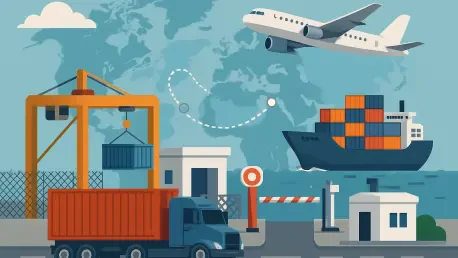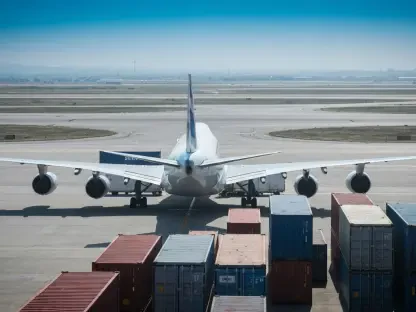What happens when a quiet tax break, fueling billions in cross-border trade, vanishes overnight, leaving the logistics world thrown into flux? Picture a scenario where the cost of a simple online purchase spikes and supply chains scramble to adapt. The de minimis rule, allowing goods under $800 to enter the U.S. duty-free, is on its way out, with full repeal slated for July 1, 2027, under the “One Big Beautiful Bill Act.” Already in effect for imports from China and Hong Kong, this policy shift is poised to redraw the map of global trade. The stakes are high for shippers, retailers, and consumers alike, as the ripple effects promise both disruption and unexpected opportunity in the realm of intermodal transport.
The significance of this change cannot be overstated. For years, the de minimis exemption has been a lifeline for e-commerce, letting small parcels slip through borders without tariffs or delays. Its removal marks a turning point, pushing companies to rethink how goods move across nations. With container usage expected to surge and intermodal activity gaining traction at key U.S. border hubs, the logistics industry stands at a crossroads. This shift isn’t just about higher costs—it’s about redefining supply chain strategies for a new era of trade barriers and domestic priorities.
Why the De Minimis Repeal Matters
The end of the de minimis exemption is more than a bureaucratic tweak; it’s a seismic jolt to the foundation of cross-border commerce. This rule has long enabled low-value shipments—think small online orders—to bypass duties, fueling a boom in direct-to-consumer imports. With its phase-out already impacting specific regions and set to expand nationwide by 2027, the logistics sector faces a stark reality: costs will rise, and delivery models must evolve. The numbers paint a clear picture—roughly 75% of U.S.-bound e-commerce shipments from certain major markets previously relied on this exemption, a dependency now under threat.
Beyond the immediate financial hit, this policy shift reflects broader tensions in global trade. It ties into efforts to bolster domestic production and impose stricter tariffs, fundamentally altering the flow of goods. For supply chain professionals, the challenge lies in navigating a landscape where every shipment, no matter how small, could face added scrutiny and expense. Consumers, too, may feel the pinch as prices climb and delivery times stretch. The urgency to adapt has never been greater, with the clock ticking toward full implementation.
Understanding the De Minimis Rule’s Role in Trade
Historically, the de minimis exemption has acted as a catalyst for e-commerce growth, streamlining the entry of low-value goods into the U.S. market. By waiving taxes and duties on shipments below $800, it created a fast lane for small parcels, particularly benefiting online retailers with vast international supply networks. The policy’s repeal, already active for select origins and expanding over the next two years, signals a pivot toward tighter control over imports, aligning with national trade agendas focused on leveling the playing field for local industries.
This change disrupts a well-oiled machine. The influx of small packages, once a hallmark of modern retail, now faces bottlenecks as duties and paperwork pile up. Logistics firms are bracing for a domino effect, where air cargo—previously a go-to for speedy e-commerce deliveries—struggles under new tariffs and oversupply. Meanwhile, the push for bulk shipping alternatives hints at a silver lining for other transport modes. The stage is set for a profound transformation, with intermodal solutions emerging as a potential lifeline in a constrained market.
Impacts Unpacked: From Small Parcels to Big Containers
The fallout from the de minimis repeal is reshaping logistics on multiple fronts. A notable trend is the shift from individual parcel shipments to containerized imports, as businesses chase cost savings through bulk transport. This pivot is expected to drive intermodal cross-border activity, especially in strategic hubs like California and Texas, where rail and truck networks intersect. Industry data suggests a marked uptick in container demand, reflecting a broader move toward efficiency in the face of rising import costs.
However, not all sectors are positioned to gain. The e-commerce industry, heavily reliant on the exemption for a significant portion of its imports, faces upheaval, with air cargo markets feeling the strain of excess capacity and declining rates. New tariffs compound these woes, squeezing margins for carriers and shippers alike. While larger players may absorb the blow, smaller retailers risk being priced out, forced to pass costs onto customers or rethink their sourcing entirely.
Challenges loom on the horizon even for those embracing intermodal growth. Heightened liability risks at border crossings, whether by rail or truck, demand stricter safety protocols and security measures. Infrastructure at key points must keep pace with increased traffic, a hurdle that could slow adaptation if not addressed. These complexities underscore a dual reality: while opportunities abound for some, others must navigate a minefield of operational and financial risks in this evolving trade landscape.
Expert Perspectives on Adapting to Change
Industry voices shed light on the practical implications of this policy upheaval. Brian Kobza, chief commercial officer at IMC Logistics, points to a clear surge in container usage and intermodal transport as a direct response to the changing rules. “We’re seeing a real push for cross-border operations, and we’re investing heavily in hubs along the border to meet that demand,” Kobza noted at a recent industry event. Yet, he cautions that liability risks at crossings remain a pressing concern, urging firms to prioritize safety to avoid costly disruptions.
On a different note, Laurent Deneubourg, VP head of airfreight at SEKO Logistics, highlights the darker side for e-commerce and air cargo. “The market is under immense pressure with tariffs and overcapacity—adaptation is the only way forward,” Deneubourg explained during the same discussion. He emphasizes the need for diversified sourcing and strategic cargo frontloading to cushion the blow. These contrasting insights reveal a fragmented industry response, where growth for some means survival struggles for others, painting a vivid picture of adaptation in action.
Strategies for Thriving in a New Trade Era
Navigating the post-de minimis landscape demands proactive measures from logistics firms and shippers. One approach is to reassess supply chain structures, prioritizing frontloading of cargo into the U.S. or regional hubs to sidestep looming cost spikes. Utilizing Foreign-Trade Zones or bonded warehouses offers another layer of flexibility, deferring duties while maintaining inventory access. Such tactics can provide breathing room as the full scope of the policy takes shape over the coming years.
For those eyeing intermodal expansion, investment in border infrastructure is critical. Strengthening rail and truck networks at key crossings can handle the anticipated surge in container traffic, but it must be paired with robust safety protocols to mitigate risks. Additionally, exploring nearshore or local production options could prove more viable than distant imports under the new cost framework. These actionable steps form a blueprint for resilience, turning a policy challenge into a strategic opportunity for those prepared to act swiftly.
Reflecting on a Transformative Shift
Looking back, the journey toward the de minimis repeal revealed a logistics industry at a pivotal moment, grappling with both disruption and potential. The shift from parcel-heavy e-commerce to container-driven intermodal transport marked a profound adaptation, as companies recalibrated to meet new trade realities. Experts and stakeholders alike wrestled with the balance of opportunity and risk, their insights illuminating the path through uncharted territory.
As the full impact unfolded, the focus turned to actionable preparation. Industry players were encouraged to deepen investments in cross-border infrastructure, refine safety measures, and explore alternative sourcing to stay competitive. Beyond immediate fixes, fostering collaboration with policymakers to clarify regulatory gaps emerged as a vital next step. This era of change, while challenging, laid the groundwork for a more resilient supply chain, poised to tackle future trade complexities with innovation and foresight.









